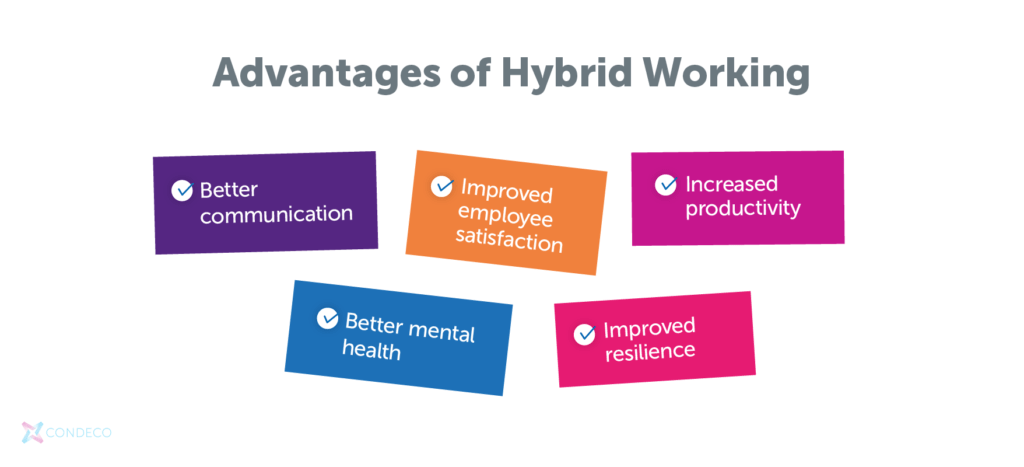

Our Attitudes to Hybrid Working Report uncovered an obvious desire to do things differently among employees. Nearly half of those currently in the office full-time want their employers to adopt some form of hybrid work. Moreover, 85% of those who have already experienced this new way of working want the option for flexible work to remain available long-term.
So why exactly is hybrid increasingly so popular across the population? As with anything, the specific reasons vary from person to person, but those reasons overwhelmingly have at least one thing in common. Flexible work options give employees more freedom, autonomy, and opportunity to build their schedules around their individual lives, resulting in higher job satisfaction and overall well-being.
What is hybrid working?
Hybrid working recognizes the benefits of having a business that operates both from an office and at home or other external locations. Typically, people may spend three days at home a week and two days in the office. Alternatively, they could choose to work from home for an entire month and then the next entirely in the office. This flexibility allows employees to decide where to do their job to be at their most productive. Already the advantages are clear to see.
You can find out more about hybrid working from this article.

Advantage 1: Better communication

Hybrid models allow individuals to experience the benefits of both realms. It enables people to work from home when they require uninterrupted focus on individual projects and to join the office on specific days and for tasks that necessitate in-person collaboration. This approach enables a flexible and balanced work environment, accommodating diverse work styles and optimizing productivity.
When it comes to workplace structures, both extremes — fully remote and always in-office — create challenges in communication. As we all know, teams that communicate exclusively via a computer screen miss out on key benefits that only spending time in person can offer. Meeting face-to-face creates opportunities for collaboration and idea-sharing that virtual work simply cannot replicate, and physically being in an office amongst colleagues fosters the kinds of social interactions that help build a company culture. Equally, requiring all employees to work out of the office every day can hinder productivity and communication just as well. Offices, for all their benefits, can also be filled with distractions, from chatty coworkers and noisy break rooms to excessive meetings and workplace gossip.
Hybrid working offers everyone a chance to enjoy the best of both worlds. People can work from home when they need to be heads-down focused on solo projects and head into the office on days and tasks that require more in-person collaboration. Under this new structure that offers greater balance, moments in the office become more valuable, and time at home is more appreciated.
Advantage 2: Improved employee satisfaction

Employee satisfaction heavily relies on independence and choice. The sense of being in control is highly valued and granting autonomy regarding how, where, and when team members of all hierarchies work will significantly enhance morale throughout the organization. Recognizing and respecting individual preferences and work styles fosters a positive and empowered workforce.
And while happy people certainly contribute to an environment that is more enjoyable for existing employees, they also play a crucial role in attracting new talent. Our research found that hybrid workers were more likely to recommend their company as an ideal workplace than any other group.
With the ever-present challenge of recruitment and retention in an increasingly competitive landscape, offering flexible work options can give you a leg up and ensure you have the best talent working for your company. It also creates an opportunity to hire from a wider pool of applicants, including high-value candidates that otherwise may have been limited by the constraints of a traditional workplace model.
Advantage 3: Increased productivity
Happy employees are also productive employees. A hybrid model can empower people to work to their strengths and when they are at their best, allowing them to be more efficient and produce higher-quality work.

Despite concerns expressed by some business leaders regarding employees becoming lazy and unproductive when working remotely, reality tells a different story. Our research reveals that 80% of managers have confidence in their teams to successfully accomplish work while operating remotely. These managers believe their employees and colleagues exhibit comparable productivity levels, whether working from home or in the office. Interestingly, in the hybrid era, the primary challenge has been ensuring that employees establish clear boundaries and disconnect at the end of the day to prevent burnout. While there may be certain drawbacks associated with the hybrid working model, decreased productivity is rarely one of them.
Advantage 4: Better mental health

In recent years, there has been a commendable shift among forward-thinking companies to prioritize employee well-being, acknowledging that work can be a significant source of stress. Providing flexible work options is crucial in fostering enhanced mental health within the workforce. Instead of compelling individuals to mold their lives around work, hybrid models empower people to shape their work patterns around their own lifestyles. By reducing the time and expenses associated with commuting, individuals can allocate more time in their day for family, friends, and personal pursuits. This, in turn, contributes to improved mental health outcomes.
Strong mental health amongst your workforce will also mean a happier workforce overall, leading to improved talent retention, lower turnover rates, and higher job satisfaction. Plus, employees who enjoy what they do and feel supported by their employer will be more motivated to use their talents and do top-notch work.
Advantage 5 – Improved resilience
Amidst the challenges posed by a global pandemic, the significance of public health and safety emerged as a focal point in discussions about workplace design and culture. The option to work remotely became crucial in endeavors to “flatten the curve,” but it also triggered a broader realization about disease prevention. By avoiding the office environment and often crowded public transportation, employees discovered a remarkable reduction in typical seasonal colds and cases of flu that were previously considered an inevitable part of life.
In many workplaces, there has long been an expectation that if you’re well enough to be out of bed, you’re well enough to report to work in the office. When people feel pressured to come in before fully recovering, they then expose their colleagues to the same illness they just had. The result is a ripple effect that ultimately leaves the entire team short-staffed and over-extended while more and more people call out sick.

Incorporating hybrid work into a company’s structure and culture instills a sense of ease among employees to utilize the work-from-home option when feeling unwell. They no longer find themselves as the sole participant dialing into virtual meetings, as the infrastructure already accommodates remote workers. By establishing flexible work as a sustainable choice, organizations can diminish the occurrence of sick days among their workforce, ultimately fostering a climate for exceptional productivity.
Everybody wins
The benefits of hybrid work extend beyond individual employees and significantly impact the entire company. As highlighted by these five examples, embracing flexible work yields substantial advantages on a company-wide level. There has never been a more opportune moment to embrace and implement flexible work arrangements, and we are here to assist you in finding the optimal solution for your business. Reach out to us to explore how we can facilitate the adoption of hybrid work, allowing you to swiftly experience its numerous benefits.



